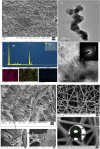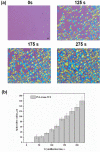Structural evolution of in situ polymerized poly(L-lactic acid) nanocomposite for smart textile application
- PMID: 36042315
- PMCID: PMC9427861
- DOI: 10.1038/s41598-022-17437-z
Structural evolution of in situ polymerized poly(L-lactic acid) nanocomposite for smart textile application
Abstract
This present study demonstrated the preparation of a highly crystalline anatase (ana) form of titanium oxide (TiO2) doped silk nanocrystal (SNC) nanohybrid (ana-TCS) of diameter (7.5 ± 1.4 nm) by the sol-gel method using titanium (IV) butoxide as the hydrolysis material. This prepared nanohybrid with surface hydroxyl groups acted as a co-initiator for the synthesis of poly(L-lactic acid) (PLLA)-g-ana-TSC nanocomposite with grafted PLLA chains via the in situ polymerization technique, using tin-octoate as a catalyst. The fabricated nanocomposite had a high number average molecular weight of 83 kDa with good processibility. This prepared nanocomposite was hydrophobic in nature, with a contact angle of 105°, which was further enhanced to 122 ± 1° when processed via electrospinning technique into a non-woven fabric. The prepared nanocomposite could degrade up to 43% methylene blue dye in 15 days. This nanocomposite showed no significant molecular weight reduction after 1 h of aqeous treatment, which could be attributed to its hydrophobic nature, inhibiting its degradation. However, 50% degradation was observed for the nanocomoposite whereas, PLLA demonstrated 25% degradation in 15 days, after its end-of-life. Thus, this study revealed that the in situ synthesized PLA-ana-TCS nanocomposite could be targeted for use as a hydrophobic, self-cleaning, dye-degradable fabric.
© 2022. The Author(s).
Conflict of interest statement
The authors declare no competing interests.
Figures







Similar articles
-
Crystalline titanium-dioxide nanofinish impregnated on electrospun stereocomplex poly (lactic acid) as non-woven nanotextile with superhydrophilic, anti-shrinkage, dark dyeing and waste dye removal ability for sustainable application.Int J Biol Macromol. 2022 Oct 31;219:384-394. doi: 10.1016/j.ijbiomac.2022.07.093. Epub 2022 Jul 16. Int J Biol Macromol. 2022. PMID: 35850271
-
In-situ polymerized cellulose nanocrystals (CNC)-poly(l-lactide) (PLLA) nanomaterials and applications in nanocomposite processing.Carbohydr Polym. 2016 Nov 20;153:549-558. doi: 10.1016/j.carbpol.2016.08.012. Epub 2016 Aug 5. Carbohydr Polym. 2016. PMID: 27561528
-
Hydrothermal synthesis of novel heterostructured Ag/TiO2 /CuFe2 O4 nanocomposite: Characterization, enhanced photocatalytic degradation of methylene blue dye, and efficient antibacterial studies.Water Environ Res. 2022 Jun;94(6):e10744. doi: 10.1002/wer.10744. Water Environ Res. 2022. PMID: 35662318
-
Preparation, characterization and evaluation of cellulose nanocrystal/poly(lactic acid) in situ nanocomposite scaffolds for tissue engineering.Int J Biol Macromol. 2019 Aug 1;134:469-479. doi: 10.1016/j.ijbiomac.2019.05.052. Epub 2019 May 9. Int J Biol Macromol. 2019. PMID: 31078594
-
Poly (lactic acid) blends: Processing, properties and applications.Int J Biol Macromol. 2019 Mar 15;125:307-360. doi: 10.1016/j.ijbiomac.2018.12.002. Epub 2018 Dec 7. Int J Biol Macromol. 2019. PMID: 30528997 Review.
Cited by
-
A Review of Polylactic Acid (PLA) and Poly(3-hydroxybutyrate) (PHB) as Bio-Sourced Polymers for Membrane Production Applications.Membranes (Basel). 2025 Jul 14;15(7):210. doi: 10.3390/membranes15070210. Membranes (Basel). 2025. PMID: 40710750 Free PMC article. Review.
References
-
- Nakasaki K, Ohtaki A, Takano H. Biodegradable plastic reduces ammonia emission during composting. Polym. Degrad. Stab. 2000;70:3–5. doi: 10.1016/S0141-3910(00)00104-X. - DOI
-
- Kalita NK, Bhasney SM, Mudenur C, Kalamdhad A, Katiyar V. End-of-life evaluation and biodegradation of poly(lactic acid) (PLA)/polycaprolactone (PCL)/microcrystalline cellulose (MCC) polyblends under composting conditions. Chemosphere. 2020;247:125875. doi: 10.1016/j.chemosphere.2020.125875. - DOI - PubMed
-
- Xiao, L., Wang, B., Yang, G. & Gauthier, M. Poly ( Lactic Acid ) -Based Biomaterials : Synthesis , Modification and Applications. (2012).
Publication types
MeSH terms
Substances
LinkOut - more resources
Full Text Sources

